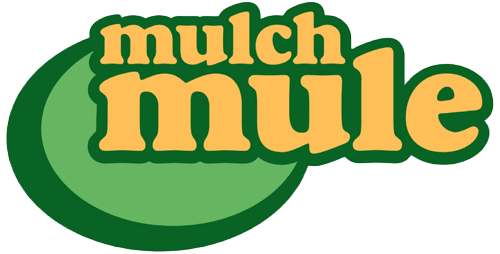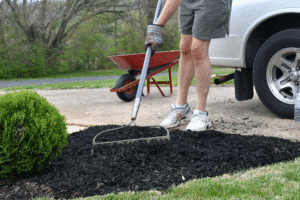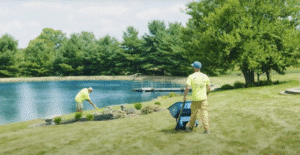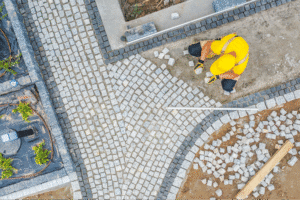The landscaping industry is witnessing a transformative shift as technology and sustainability continually influence everyday workflows. Recent advancements in automating landscaping tasks, data-driven tools, and environmentally conscious practices are streamlining operations, reducing costs, and enhancing safety. In an increasingly competitive market, integrating these innovations is becoming essential for landscaping businesses planning for the future.
This article explores how technology, particularly streamlined processes, is reshaping landscaping and examines the significance of sustainable practices in minimizing resource use and waste. It also discusses how innovative solutions, such as advanced material-handling equipment, empower professionals to boost efficiency and improve workplace safety.
Embracing Technology and Sustainability in Landscaping
Today’s landscaping professionals face growing demands for enhanced efficiency, cost reduction, and environmental responsibility. Technological innovations—such as automated equipment, IoT sensors, and smart scheduling—are transforming labor-intensive tasks into streamlined processes that reduce safety risks and improve productivity. At the same time, eco-friendly practices enable companies to meet regulatory requirements and align with the values of environmentally conscious clients. The result is a powerful synergy: integrating technology with sustainability to build a resilient and competitive business model.
The Role of Technology in Advancing Landscaping
As the landscaping industry continues to progress, technology serves as a fundamental catalyst in this transformation. The shift from manual to automated processes is not only revolutionizing the way tasks are performed but also promoting efficiency and safety. With the integration of cutting-edge technology, landscaping businesses can better meet the demands of modern-day operations, from reducing labor intensity to ensuring sustainable practices. Technological advancements allow landscaping professionals to achieve higher levels of productivity and quality in their projects, setting themselves up for success in a competitive marketplace.
Key Technological Advancements
Modern landscaping tools are rapidly evolving from manual operations to more automated systems. Sensors, GPS, and remote operation capabilities not only reduce the need for intensive labor but also enable advanced equipment to perform complex tasks with minimal human intervention. Features like predictive maintenance enhance operational efficiency by providing alerts about potential issues before they lead to costly downtime. Additionally, following EPA recommendations for green landscaping can help align these technological forward steps with environmental considerations.
Efficiency and Cost Savings Through Automation
Automation helps address labor challenges by taking over repetitive or hazardous tasks. For example, systems designed for material handling can help streamline operations and potentially reduce the hours needed for manual labor while contributing to a safer work environment. In this regard, AI-driven solutions play a crucial role in mitigating risks while boosting productivity. They can also gather insights on equipment usage, fleet routing, and scheduling—enabling companies to identify more cost-effective ways to deploy their workforce.
Enhancing Safety with Smart Features
Advanced landscaping tools increasingly incorporate safety-enhancing features such as obstacle detection, real-time terrain adjustments, and emergency shutdown mechanisms. Data-driven platforms that track equipment usage and environmental conditions assist companies in refining their safety protocols and reducing the likelihood of accidents. By reducing the extent of manual intervention, these systems help protect workers and support adherence to evolving safety standards set by agencies like OSHA.
Spotlight on the Mulch Mule Trailer
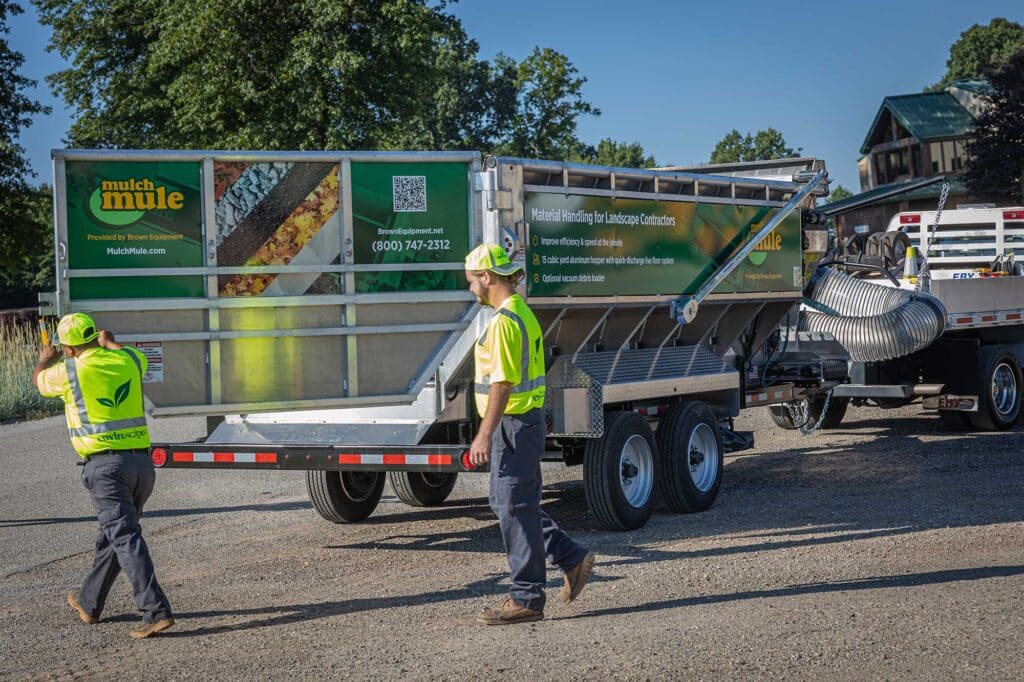
An example of technological integration in material handling is seen in the Mulch Mule Trailer. This trailer features an automated discharge system designed to improve workflow efficiency and reduce the manual effort required during material handling. With a focus on durability, an aluminum hopper, and ease of use, the trailer is engineered to support efficient fuel utilization and minimize worker exposure to debris and physical strain. Landscaping businesses benefit from these improvements by saving time, enhancing safety, and positioning themselves to achieve greater profitability in their operations.
Technology represents a transformative force in the landscaping industry. By embracing innovations such as automation, AI-driven solutions, and smart safety features, landscaping businesses can achieve significant improvements in efficiency, safety, and sustainability. This technological evolution not only streamlines operations but also aligns with a growing demand for eco-friendly practices, ultimately positioning businesses toward future growth and success in a competitive market.
Sustainability as a Key Driver in Landscaping
Environmental responsibility has become increasingly central in the landscaping industry. Clients and regulators are progressively expecting companies to adopt sustainable practices—from energy-efficient equipment to initiatives that reduce overall waste. Embracing eco-friendly tools not only meets these expectations but also enhances a company’s reputation and market competitiveness.
Sustainable Equipment Design and Benefits
Modern landscaping equipment is gradually being designed for resource efficiency. Tools powered by alternative energy sources, for instance, are under development as potential alternatives to traditional gas-powered machines. While it is early to generalize about their performance, such equipment promises benefits like reduced noise and lower emissions. Investments in sustainable machinery can lead to long-term savings, improved customer trust, and competitive advantages in an eco-conscious marketplace.
Combining Technology with Sustainability
By integrating hyper-efficiency with eco-friendly practices, businesses can enhance safety, reduce labor costs, and lower their environmental footprint. For instance, autonomous mowers powered by cleaner energy sources can help maintain lawns while avoiding the harmful emissions typically associated with gasoline-powered machines. This integration not only supports operational efficiency but also assists companies in meeting increasingly stringent environmental standards.
Financial and Operational Advantages
Adopting a mix of innovative and sustainable tools can result in significant financial benefits. Lower labor expenses, reduced fuel consumption, and optimized maintenance routines contribute to a strong return on investment. The use of advanced material-handling systems and resource-efficient equipment can accelerate project turnaround times while maintaining high operational and environmental standards. Over time, these benefits position landscaping companies for higher margins and continued growth.
Innovations in Landscaping Tools
As landscaping technology continues to evolve, the introduction of innovative tools is transforming industry practices, driving efficiency, and supporting sustainability. These advancements enable landscaping professionals to implement smarter, more cost-effective solutions that meet growing expectations for environmental responsibility and operational excellence. By leveraging the power of smart features and energy-efficient designs, the industry is poised for significant progress, offering businesses a competitive edge.
Smart Tools and IoT Integration
The next wave of landscaping technology involves integrating smart sensors and Internet of Things (IoT) capabilities to gather real-time data. Equipment equipped with IoT features can adjust operations based on factors such as soil conditions and weather, enhancing efficiency and reducing waste. Centralized data collection supports improved decision-making and predictive maintenance, minimizing downtime and energy usage. Overcoming these challenges can lead to more consistent job quality and profitability gains.
Advancements in Battery-Powered and Fuel-Efficient Equipment
Battery-powered landscaping tools are under development as alternatives to traditional gas-powered machines. Some advantages in current innovations include quieter operation and reduced emissions, although runtime and charging speed can vary between models. Hybrid systems that incorporate both conventional engines and electric motors are being explored as a means of balancing performance and sustainability.
Enhancing Safety and Efficiency
The convergence of smarter technology with fuel-efficient equipment is setting new standards for safety and efficiency. IoT-enabled systems can reduce the need for manual interventions in hazardous environments, while remote operation capabilities allow safe management of challenging terrains—ensuring that essential tasks continue without compromising worker safety. As these solutions advance, they further drive down overall labor expenses and improve on-site operational excellence.
Incorporating smart, energy-efficient innovations is reshaping the landscape of landscaping tools, enhancing both safety and performance. As these advancements continue to gain traction, they promise to revolutionize operational workflows, promote environmental stewardship, and support sustained growth and competitiveness within the industry. The alignment of cutting-edge technology with eco-friendly objectives ensures that landscaping businesses are well-equipped to address contemporary challenges while paving the way for a more sustainable and efficient future.
Preparing Landscaping Businesses for the Future
To fully benefit from technological advancements, landscaping companies must assess their existing operations and pinpoint tasks where automation can replace manual labor. Introducing pilot projects on selected job sites can help benchmark the impact of new equipment and provide a data-driven basis for broader adoption. Incorporating versatile tools with interchangeable attachments can also reduce the need for multiple machines and simplify overall operations.
While the initial investment in advanced, sustainable equipment may be significant, long-term savings on labor, fuel, and maintenance expenses often justify the upfront costs. Flexible financing options and government incentives can alleviate these expenses. Equally important is training employees to operate new technologies efficiently, with hands-on lessons and continued support ensuring a smooth transition and maximum benefits from modern equipment. By properly allocating resources to both budgeting and training, businesses can capitalize on these transformative tools and drive profitability.
Overcoming Integration Challenges
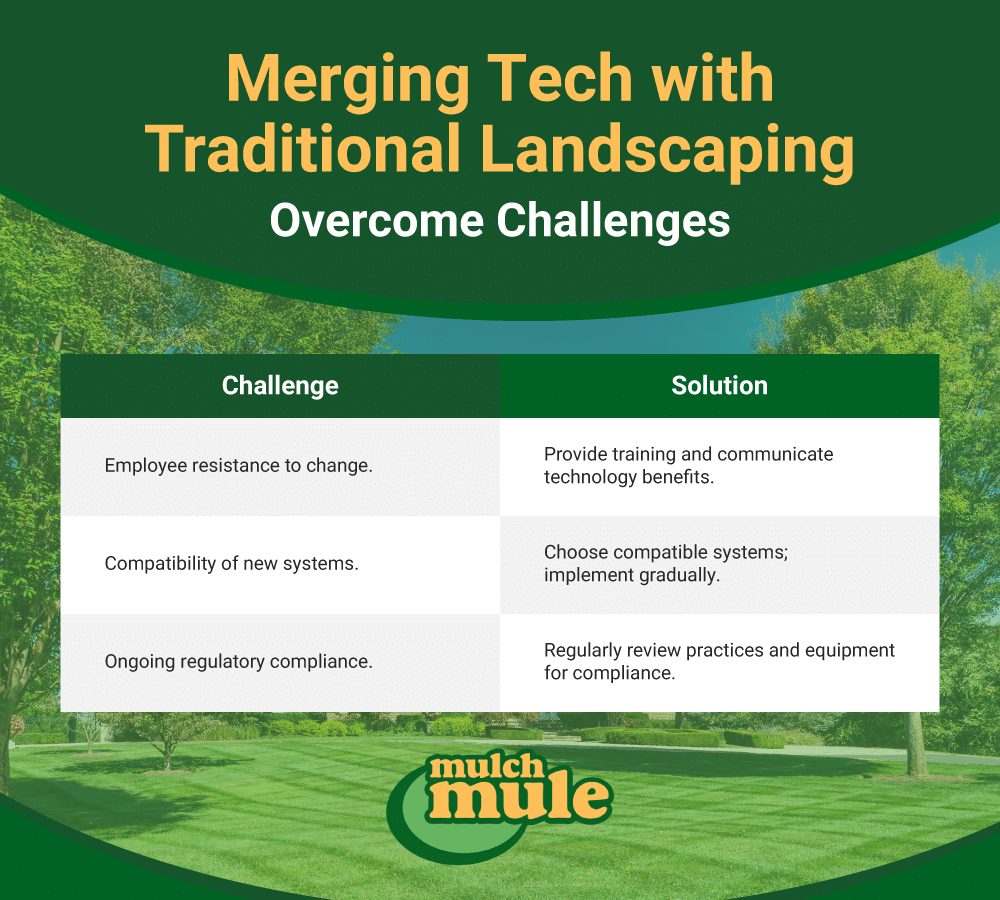
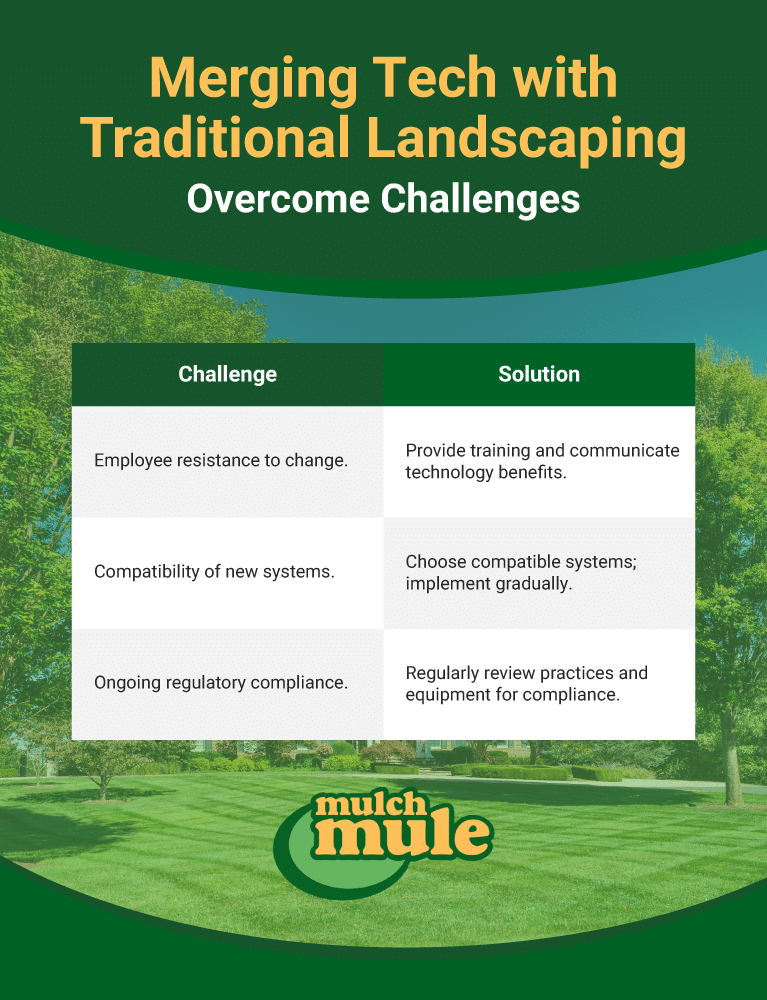
Adopting new technology in landscaping is not without obstacles. Companies frequently encounter employee resistance to change when transitioning from conventional machinery to modern automated systems. Comprehensive training programs and clear communication about the benefits of new technology can help ease this process. Successful integration depends on selecting compatible systems and planning phased implementations that allow for gradual testing and refinement.
Ongoing regulatory compliance and evolving safety standards necessitate consistent attention. Regular reviews of equipment and operational practices help companies adapt to change and maintain maximum reliability. These measures build confidence among employees and clients alike, ensuring the adoption of technology truly enhances overall performance and outcomes.
Emerging Best Practices and Integration Strategies
As the landscaping industry evolves, embracing best practices for technology integration is essential. Many businesses are now employing real-time monitoring systems that provide continuous feedback on equipment performance and environmental conditions, facilitating rapid adjustments to reduce downtime and inefficiencies. Collaborative online platforms that connect teams across multiple sites enhance communication and help maintain consistent operational standards. Adopting these practices not only boosts productivity but also enables companies to adapt quickly to market demands.
Mulch Mule’s Approach to Innovation
Mulch Mule offers material-handling solutions that aim to enhance workflow efficiency while improving operational safety and profitability. Their Mulch Mule Trailer features an automated discharge system to reduce manual handling efforts, cutting labor costs and accelerating project timelines. By streamlining processes, Mulch Mule helps landscaping companies allocate resources more effectively so they can focus on scaling operations and improving margins.
With the ability to repurpose your manpower and take on more projects because of its efficiencies, the Mulch Mule material handler is an investment that can pay for itself.
- Fill a wheelbarrow in 3-6 seconds.
- Improve efficiency & speed at the jobsite
- 15 cubic yard aluminum hopper with quick-discharge live floor system
- Optional vacuum debris loader
Catch a quick glimpse of the Mulch Mule at work with this quick video below:
Comprehensive Support and Resources
Beyond providing equipment, Mulch Mule also offers support through their Ambassador Program, and extensive parts and warranty services. These resources are intended to help clients integrate new tools into their operations more confidently, extend equipment lifespan, and maintain consistent performance. The goal is to ensure Mulch Mule solutions continue to deliver tangible returns and progressively adapt to future industry trends.
Shaping the Future of Landscaping
The future of landscaping lies in the effective integration of technology and sustainability. Automation, data-driven insights, and environmentally responsible practices are crucial for creating safer job sites, reducing dependency on manual labor, and optimizing resource use. Landscaping professionals adopting these innovations can enhance productivity, reduce costs, and meet evolving environmental standards while staying ahead in a competitive marketplace.
By investing in advanced tools and sustainable practices, businesses can prepare for long-term success in a rapidly evolving industry. Embrace the future of landscaping technology to safeguard your company’s growth and reap the benefits of a more efficient operation. Get a quote from Mulch Mule today and discover a path toward increased efficiency, profitability, and sustainability.
